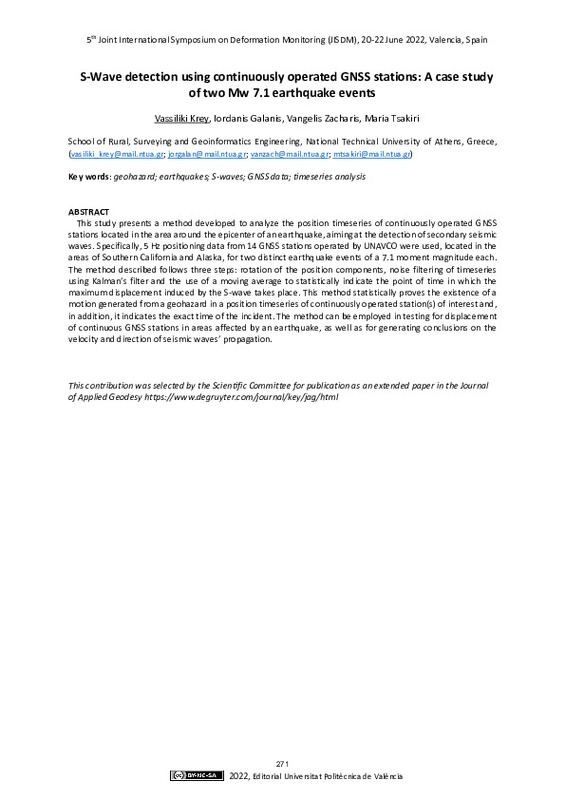JavaScript is disabled for your browser. Some features of this site may not work without it.
Buscar en RiuNet
Listar
Mi cuenta
Estadísticas
Ayuda RiuNet
Admin. UPV
S‐Wave detection using continuously operated GNSS stations: A case study of two Mw 7.1 earthquake events
Mostrar el registro sencillo del ítem
Ficheros en el ítem
| dc.contributor.author | Krey, Vassiliki
|
es_ES |
| dc.contributor.author | Galanis, Iordanis
|
es_ES |
| dc.contributor.author | Zacharis, Vangelis
|
es_ES |
| dc.contributor.author | Tsakiri, Maria
|
es_ES |
| dc.date.accessioned | 2023-02-23T10:48:04Z | |
| dc.date.available | 2023-02-23T10:48:04Z | |
| dc.date.issued | 2023-01-27 | |
| dc.identifier.isbn | 9788490489796 | |
| dc.identifier.uri | http://hdl.handle.net/10251/192041 | |
| dc.description.abstract | [EN] This study presents a method developed to analyze the position timeseries of continuously operated GNSS stations located in the area around the epicenter of an earthquake, aiming at the detection of secondary seismic waves. Specifically, 5 Ηz positioning data from 14 GNSS stations operated by UNAVCO were used, located in the areas of Southern California and Alaska, for two distinct earthquake events of a 7.1 moment magnitude each. The method described follows three steps: rotation of the position components, noise filtering of timeseries using Kalman’s filter and the use of a moving average to statistically indicate the point of time in which the maximum displacement induced by the S-wave takes place. This method statistically proves the existence of a motion generated from a geohazard in a position timeseries of continuously operated station(s) of interest and, in addition, it indicates the exact time of the incident. The method can be employed in testing for displacement of continuous GNSS stations in areas affected by an earthquake, as well as for generating conclusions on the velocity and direction of seismic waves’ propagation. | es_ES |
| dc.language | Inglés | es_ES |
| dc.publisher | Editorial Universitat Politècnica de València | es_ES |
| dc.relation.ispartof | 5th Joint International Symposium on Deformation Monitoring (JISDM 2022) | |
| dc.rights | Reconocimiento - No comercial - Compartir igual (by-nc-sa) | es_ES |
| dc.subject | Global Navigation Satellite system (GNSS) | es_ES |
| dc.subject | Geohazard | es_ES |
| dc.subject | Earthquakes | es_ES |
| dc.subject | S-waves | es_ES |
| dc.subject | GNSS data | es_ES |
| dc.subject | Timeseries analysis | es_ES |
| dc.title | S‐Wave detection using continuously operated GNSS stations: A case study of two Mw 7.1 earthquake events | es_ES |
| dc.type | Capítulo de libro | es_ES |
| dc.type | Comunicación en congreso | es_ES |
| dc.rights.accessRights | Abierto | es_ES |
| dc.description.bibliographicCitation | Krey, V.; Galanis, I.; Zacharis, V.; Tsakiri, M. (2023). S‐Wave detection using continuously operated GNSS stations: A case study of two Mw 7.1 earthquake events. En 5th Joint International Symposium on Deformation Monitoring (JISDM 2022). Editorial Universitat Politècnica de València. http://hdl.handle.net/10251/192041 | es_ES |
| dc.description.accrualMethod | OCS | es_ES |
| dc.relation.conferencename | 5th Joint International Symposium on Deformation Monitoring | es_ES |
| dc.relation.conferencedate | Junio 20-22, 2022 | es_ES |
| dc.relation.conferenceplace | València, España | es_ES |
| dc.relation.publisherversion | http://ocs.editorial.upv.es/index.php/JISDM/JISDM2022/paper/view/13834 | es_ES |
| dc.type.version | info:eu-repo/semantics/publishedVersion | es_ES |
| dc.relation.pasarela | OCS\13834 | es_ES |






